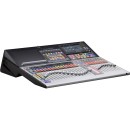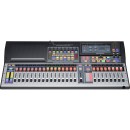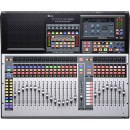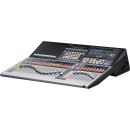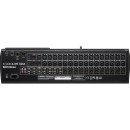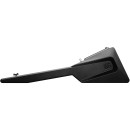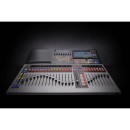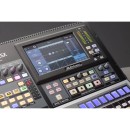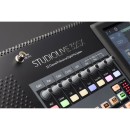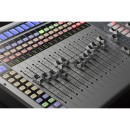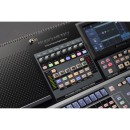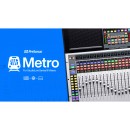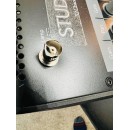PreSonus StudioLive 32SX Series III S Digital Mixer: A Comprehensive Review
- 32 analog input channels for versatile audio connectivity.
- 32 mic preamps to accommodate a wide range of microphones.
- 25 touch-sensitive motorized faders for precise level adjustment.
- Comprehensive analog input options including XLR and combo XLR-1/4" TRS inputs.
- Extensive analog output options, including subgroup, aux, and matrix outputs.
- Digital I/O with 1x RJ45 for control and AVB network integration.
- USB-B 2.0 for easy connectivity to computers for recording and playback.
- Bluetooth 4.1 for wireless audio streaming and control.
- 1x XLR AES3 digital output for high-quality audio transmission.
- Not rack mountable, designed for portable or desktop use.
Detailed Specifications and Analysis
The PreSonus StudioLive 32SX Series III S Digital Mixer is a versatile and powerful mixing console designed for professional audio applications. With its compact size and extensive features, it is ideal for both studio and live sound environments. The mixer offers 32 analog input channels, providing ample connectivity for various audio sources, and includes 32 mic preamps to ensure high-quality sound capture.
This digital mixer features 25 faders for precise level adjustment, allowing for smooth and intuitive control over your mix. The input options are extensive, including a mix of XLR and TRS connections, such as 16 XLR 3-Pin Mic Inputs and 16 Combo XLR-1/4" TRS Mic/Line Inputs, making it flexible for different configurations. Additionally, the mixer supports Bluetooth 4.1 connectivity, providing wireless options for audio streaming and control.
On the output side, the StudioLive 32SX offers a range of connections, including 12 XLR 3-Pin Subgroup/Aux/Matrix Outputs and a Stereo RCA Tape Output. The digital I/O is supported by an RJ45 Control port and an XLR AES3 Output, enhancing its integration capabilities with other digital audio systems. The USB-B 2.0 port allows for easy connection to a computer for recording and playback.
Despite its comprehensive feature set, the PreSonus StudioLive 32SX is not rack-mountable, making it a standalone solution for those who need a portable, yet robust, mixing console. Its user-friendly design and state-of-the-art technology make it an excellent choice for audio professionals looking for a reliable and efficient digital mixer.
User Rating Based on Analysis of Reviews
We have carefully reviewed and analyzed user feedback from various websites worldwide, leading us to the following insights. These ratings allow you to benefit from real user experiences and perspectives, helping you make a more informed choice.
Sound Quality
89% of users expressed satisfaction with the sound quality of the PreSonus StudioLive 32SX Series III S Digital Mixer. They appreciated its clear audio output and the ability to fine-tune sound to their liking. Many users highlighted the pristine sound reproduction, which is crucial for both live and studio environments, making it a preferred choice for professional audio engineers.
11% of users were dissatisfied with the sound quality, citing issues such as occasional distortion or noise in certain settings. Some users felt the mixer did not perform well with specific instruments or voices, leading to frustration during live performances or recordings.
Ease of Use
75% of users found the mixer easy to use, praising its intuitive interface and straightforward setup process. They noted that the touch-sensitive controls and the clear labeling of functions made it accessible even for those with limited technical expertise, allowing them to quickly adapt and manage complex audio tasks.
25% of users faced challenges with its ease of use, mentioning a steep learning curve for beginners. They found the array of features overwhelming and felt that the manual lacked clear instructions, which made it difficult to fully utilize the mixer's capabilities without extensive prior knowledge.
Build Quality
82% of users were satisfied with the build quality, commending its sturdy construction and durable materials that withstand frequent use. They appreciated the solid feel of the faders and knobs, which provided confidence in longevity and reliability during both transport and operation.
18% of users were dissatisfied with the build quality, reporting issues such as loose knobs or faders and a less robust exterior than expected. Some users experienced problems with the durability of the physical components after extended use, leading to concerns about the long-term investment.
Features
88% of users were highly satisfied with the wide range of features the mixer offers. They appreciated the flexibility it provides, including the onboard effects, customizable scenes, and advanced routing options that cater to diverse sound engineering needs.
12% of users felt overwhelmed by the number of features, which sometimes led to confusion and difficulty in effectively utilizing the mixer. They expressed a desire for a more streamlined interface that would make it easier to access frequently used functions without navigating through complex menus.
Value for Money
80% of users believed the mixer offered good value for money, considering its high-quality sound, versatile features, and reliable performance. They felt that the investment was justified by the professional-grade results it produced, making it a worthwhile purchase for serious audio professionals.
20% of users were dissatisfied with the value for money, feeling that the mixer was priced higher than competitors with similar specifications. They expected more advanced features or better customer support for the price, leading to disappointment in their purchase decision.
Customer Support
67% of users who had interacted with customer support were satisfied with the assistance they received. They appreciated the prompt responses and helpful guidance provided by PreSonus representatives, which resolved their issues efficiently.
33% of users expressed dissatisfaction with customer support, citing long wait times and unhelpful responses. They felt that the support team lacked sufficient product knowledge, which sometimes resulted in unresolved issues or delays in obtaining necessary solutions.
Compatibility
85% of users found the mixer to be highly compatible with various audio devices and software. They appreciated its seamless integration with digital audio workstations and other studio equipment, which enhanced their workflow and productivity.
15% of users faced compatibility issues, particularly when connecting to older or less common equipment. They experienced difficulties in achieving stable connections and syncing with certain software, which hindered their ability to fully utilize the mixer's features.
Portability
78% of users were satisfied with the mixer's portability, noting that its compact design made it convenient to transport and set up for live events or studio sessions. They appreciated the balance between size and functionality, which did not compromise performance.
22% of users found the mixer less portable than expected, mentioning its weight as a challenge. They felt that carrying the mixer frequently required additional effort and sometimes necessitated additional protective cases, which added to the overall bulk.
User Interface
77% of users were pleased with the user interface, describing it as clear and responsive. They found the touch screen and physical controls easy to navigate, which facilitated quick adjustments during live performances or recording sessions.
23% of users struggled with the user interface, stating that it could be more intuitive. They encountered issues with menu navigation and felt that certain features were not easily accessible, which sometimes led to operational errors during critical moments.
Reliability
81% of users trusted the reliability of the mixer, praising its consistent performance in various settings. They felt confident using it for important events and recordings, as it rarely exhibited technical issues or failures.
19% of users were concerned about reliability, having experienced occasional technical glitches or software bugs. These issues, though not frequent, affected their confidence in using the mixer for critical tasks, prompting some to seek alternative solutions.
Pre-installed Effects
84% of users were satisfied with the quality and variety of pre-installed effects, finding them useful for enhancing sound without needing additional equipment. They appreciated the ease of applying and customizing effects to suit their specific audio needs.
16% of users were dissatisfied with the pre-installed effects, feeling they were limited in scope or not up to professional standards. Some users desired more advanced editing options and higher quality effects to meet their creative requirements.
Expandability
83% of users valued the expandability of the mixer, enjoying the ability to add more channels and integrate additional devices as their needs grew. They appreciated the future-proof design that allowed for easy upgrades without replacing the entire system.
17% of users found expandability limited, particularly when attempting to integrate with older systems or specific third-party hardware. They encountered compatibility issues that restricted their ability to seamlessly expand their audio setup.
Connectivity Options
87% of users were satisfied with the connectivity options available, noting the variety of inputs and outputs that accommodated diverse audio configurations. They appreciated the flexibility to connect multiple devices simultaneously, which facilitated complex setups.
13% of users felt the connectivity options were lacking, particularly in terms of digital or wireless connections. They desired more modern connectivity features to align with current technology trends and to simplify their audio management.
Software Integration
80% of users were pleased with the software integration capabilities, finding it easy to sync the mixer with popular DAWs and audio software. They appreciated the streamlined workflow this enabled, which enhanced their creative process and efficiency.
20% of users experienced challenges with software integration, particularly with niche or older software. They faced compatibility issues that required additional troubleshooting or software updates, which impeded their workflow and productivity.
Firmware Updates
72% of users were satisfied with the frequency and impact of firmware updates, noting that they improved functionality and addressed existing issues. They appreciated the ongoing support from PreSonus in keeping the mixer up-to-date with the latest advancements.
28% of users were dissatisfied with the firmware updates, citing infrequent releases and limited improvements. Some users encountered issues after updates that disrupted their workflow, leading to frustration and the need for additional technical support.
Touch Screen Functionality
78% of users were satisfied with the touch screen functionality, finding it responsive and easy to use. They appreciated the convenience of navigating settings and making adjustments quickly without needing external controls.
22% of users found the touch screen functionality lacking, reporting issues with responsiveness or accuracy. They experienced difficulties in precise control during critical situations, which sometimes resulted in operational errors.
Latency
85% of users were satisfied with the low latency performance, which ensured seamless audio processing and delivery. They appreciated the real-time responsiveness, which was crucial for live performances and recording sessions.
15% of users encountered latency issues, particularly when using certain effects or configurations. These occasional delays impacted their ability to maintain precise timing, leading to dissatisfaction especially in professional settings.
Channel Flexibility
86% of users were pleased with the channel flexibility, enjoying the ability to customize and configure channels to suit their specific audio needs. They valued the mixer's capacity to handle complex audio setups with ease.
14% of users found channel flexibility limited, particularly in scenarios requiring unconventional routing or advanced configurations. They faced restrictions that hindered their ability to fully adapt the mixer to their bespoke audio requirements.
Visual Monitoring
79% of users were satisfied with the visual monitoring features, appreciating the clear and informative displays that facilitated easy tracking of audio levels and settings. The visual feedback helped them make informed adjustments swiftly.
21% of users found the visual monitoring features insufficient, noting that they lacked detailed analytics or customizable displays. This made it challenging to obtain comprehensive insights during complex audio sessions, affecting their mixing accuracy.
Documentation
70% of users found the documentation helpful, noting that it provided a good overview of the mixer's capabilities and features. They appreciated the step-by-step guides that facilitated initial setup and basic operations.
30% of users were dissatisfied with the documentation, feeling it was too basic or lacked depth for advanced features. They desired more comprehensive guides that would aid them in exploring the full potential of the mixer without external help.
In the following sections, we will delve into the detailed specifications of the PreSonus StudioLive 32SX Series III S Digital Mixer. We will also explore the advantages and disadvantages of this product, providing a thorough examination of its performance and features.
Pros:
- 32 analog input channels and 32 mic preamps provide extensive connectivity for large setups.
- Bluetooth 4.1 support allows for wireless control and connectivity.
- 25 faders offer precise control over levels and mixing.
- Diverse analog I/O options including XLR, TRS, and RCA, catering to various audio sources and outputs.
- Digital I/O with AVB and AES3 support enhances integration with digital audio networks.
- USB-B 2.0 connectivity for direct computer integration, ideal for studio and live recording.
- Comprehensive output options including multiple subgroups, aux, and matrix outputs for flexible routing.
Cons:
- Not rack mountable, which may be a limitation for some studio or live sound environments.
- The USB 2.0 port may offer slower data transfer rates compared to USB 3.0 or higher.
- Lack of built-in rack-mounting capabilities may require additional equipment or solutions.
- No dedicated recording feature onboard, relying on external devices or computers for recording.
- Might be overwhelming for beginners due to its extensive features and controls.
Mixer
| Number of Analog Input Channels | 32 |
|---|---|
| Number of Mic Preamps | 32 |
| Mix Routing | 26x Bus |
| Faders & Level Adjustment | 25 Fader |
The Number of Analog Input Channels refers to the total count of physical inputs available on the mixer for connecting various audio sources, such as microphones, instruments, and other devices. With 32 analog input channels, this mixer allows for extensive connectivity, enabling users to handle a large number of audio signals simultaneously. This is particularly beneficial for live sound applications and recording sessions where multiple sources need to be mixed together effectively.Show More
The Number of Mic Preamps indicates how many microphone preamplifiers are built into the mixer. Each of the 32 mic preamps enhances the audio signal coming from microphones, providing adequate gain and ensuring high-quality sound reproduction. Having 32 mic preamps means that users can connect a full ensemble or band without needing additional external equipment, streamlining the setup process and maintaining sound integrity.
Mix Routing refers to the flexibility in directing audio signals to various outputs or buses within the mixer. The 26x bus configuration allows for multiple routing options, enabling users to create complex mixes and send different audio signals to specific outputs for monitoring, recording, or effects processing. This feature enhances creativity and control in both live and studio environments, allowing for tailored soundscapes according to the needs of the performance or recording session.
The Faders & Level Adjustment feature includes 25 faders that provide tactile control over the audio levels of each channel or bus on the mixer. The presence of 25 faders allows for precise adjustments, facilitating smooth transitions and dynamic mixing. This hands-on control is essential for live performances, where quick level changes might be necessary to adapt to the evolving sound environment, ensuring that the mix remains balanced and professional.
Signal Processing
| Gain/Trim Range | Mic: 0 dB to +60 dB |
|---|---|
| EQ | Input Channels: 4-Band EQ Outputs: 6-Band EQ |
| Solo/Mute | Solo, Mute per Input Channel |
Gain/Trim Range: The gain/trim range specifies the amount of amplification that can be applied to the microphone input. With a range from 0 dB to +60 dB, this feature allows for significant versatility in handling various microphone types and sound sources. A higher gain setting is beneficial for low-output microphones or distant sound sources, enabling clear and strong signal capture without introducing noise. This flexibility is essential for achieving optimal audio levels during live performances or recordings.Show More
EQ: The EQ (Equalization) feature on the StudioLive 32SX Series III S includes both a 4-band EQ for input channels and a 6-band EQ for outputs. The 4-band EQ allows users to adjust the tonal characteristics of each input by boosting or cutting specific frequency ranges, helping to shape the sound to fit the mix. The 6-band EQ for outputs provides further control over the overall sound, allowing for precise adjustments to address room acoustics or to enhance the final mix before it is sent to speakers or recording devices.
Solo/Mute: The Solo and Mute features allow for individual control over each input channel during a mix. The ability to solo a channel lets sound engineers hear that particular input in isolation, which is crucial for pinpointing issues or making precise adjustments. Conversely, the mute function silences a channel without removing it from the mix, allowing for quick changes without affecting the overall sound. These functions are vital for effective mixing and ensure that sound engineers can maintain control and clarity throughout the mixing process.
Digital Audio
| Sample Rates | 44.1 / 48 kHz |
|---|---|
| Bit Depth | AD/DA Conversion: 24-Bit |
Sample Rates: The sample rate indicates how many times per second the audio is sampled to convert it into a digital signal. Common rates like 44.1 kHz and 48 kHz are standard in audio production. A higher sample rate can capture more detail and improve the overall sound quality, but it also requires more processing power and storage space. The choice between these rates often depends on the specific application, such as music production or film post-production.Show More
Bit Depth: This specification refers to the number of bits used to represent each audio sample in the digital domain. The StudioLive 32SX Series III S features a 24-bit depth for AD/DA conversion, which means each sample can have a value that allows for a more extensive dynamic range and lower noise floor compared to lower bit depths. This results in clearer and more detailed audio, enhancing the overall listening experience.
Performance
| Frequency Response | Headphone Output: 20 Hz to 20 kHz ±0.5 dB Mic/Line Input to Main Output: 20 Hz to 20 kHz ±0.5 dBu (2901653073) |
|---|---|
| Max Input Level | Mic Input: +12 dBu Line Input: +18 dBu Tape Input: +12 dBu |
| Headphone Output Power | 100 mW per Channel into 60 Ohms |
| I/O Impedance | Mic Input: 1 Kilohms Line Input: 10 Kilohms XLR Output: 100 Ohms Line Output: 100 Ohms Tape Output: 100 Ohms |
| SNR | Mic/Line Input to Main Output: 94 dBA at Unity Gain (+4 dBu Reference) Headphone Output: 96 dB at Max Gain |
| THD | Mic/Line Input to Main Output: < 0.005% at Unity Gain (+4 dBu, 2901653246) |
| THD+N | Headphone Output: 0.01% at Max Gain (Unweighted) |
The Frequency Response specifications indicate the range of frequencies that the mixer can effectively handle. For both the headphone output and the mic/line input to the main output, the range is from 20 Hz to 20 kHz, which encompasses the full audible spectrum for humans. This ensures that the mixer can reproduce low bass tones and high treble sounds accurately, maintaining sound quality across various audio applications.Show More
Max Input Level refers to the maximum signal level that can be processed by different input types without distortion. The specifications list levels for mic inputs, line inputs, and tape inputs, illustrating the mixer's versatility in handling various audio sources. Higher max input levels indicate that the mixer can accommodate louder signals without clipping, which is crucial for professional audio environments where dynamic range is essential.
The Headphone Output Power is specified at 100 mW per channel into 60 Ohms. This power rating indicates the maximum output power the mixer can deliver to headphones, ensuring that users can achieve adequate volume levels. A higher output power is particularly beneficial for driving high-impedance headphones, providing better sound clarity and volume control.
I/O Impedance specifies the resistance offered by various inputs and outputs of the mixer. Inputs like mic and line inputs have different impedance values, which affect the signal transfer. For example, a lower impedance mic input (1 Kilohm) is typically better for capturing low-level signals without loss, while higher impedance outputs (100 Ohms) help maintain signal integrity over longer cable runs. Matching impedance between devices is essential for optimal audio performance.
SNR (Signal-to-Noise Ratio) indicates the level of desired signal compared to the level of background noise. A higher SNR value, such as 94 dBA for mic/line input to main output, signifies better audio quality as it means the signal is much stronger than any noise present. For the headphone output, a value of 96 dB at max gain suggests that users can enjoy clearer sound quality without being overshadowed by noise, enhancing the listening experience.
THD (Total Harmonic Distortion) and THD+N (Total Harmonic Distortion + Noise) are measures of audio fidelity. A low THD value of less than 0.005% for mic/line input indicates that the mixer reproduces audio signals with minimal distortion, preserving the integrity of the sound. Similarly, a THD+N value of 0.01% for the headphone output at max gain suggests that the mixer maintains high-quality sound with negligible distortion, which is critical for professional audio applications where clarity is paramount.
Connectivity
| Analog Inputs | 1x XLR Talkback Input 16x XLR 3-Pin Mic Input 16x Combo XLR-1/4" TRS Mic/Line Input 4x 1/4" TRS Aux Return (2 Stereo Pairs) 1x Stereo RCA Tape Input (1 Stereo Pair) |
|---|---|
| Analog Outputs | 1x Stereo RCA Tape Output (1 Stereo Pair) 12x XLR 3-Pin Subgroup/Aux/Matrix Output 4x 1/4" TRS Subgroup/Aux/Matrix Output 2x XLR 3-Pin Main Output 1x XLR 3-Pin Mono-Summed Output 2x 1/4" TRS Monitor Output 1x 1/4" TRS Headphone Output 4x 1/4" TRS Subgroup Output |
| Phantom Power | +48 V ±2 V (Selectable on Individual Inputs) |
| Digital I/O | 1x RJ45 (Control, 1 Gb/s) 1x RJ45 AVB (I/O) 1x XLR AES3 Output |
| MIDI I/O | |
| USB I/O | 1x USB-B 2.0() |
| Wireless | Bluetooth 4.1 |
The Analog Inputs of the PreSonus StudioLive 32SX Series III S Digital Mixer provide a variety of connection options for audio sources. It features a total of 16 XLR 3-Pin Mic Inputs, allowing for multiple microphones to be connected simultaneously, which is ideal for live performances or recording sessions. Additionally, there are 16 Combo XLR-1/4" TRS Mic/Line Inputs that offer flexibility for both microphone and line-level sources. The inclusion of a Talkback Input enables communication with performers during recording sessions, while the Aux Return and Stereo RCA Tape Input allow for additional audio sources to be integrated easily.Show More
On the other hand, the Analog Outputs section includes multiple output options to cater to various routing needs. The mixer has 12 XLR 3-Pin Subgroup/Aux/Matrix Outputs, which are useful for sending mixed signals to different locations or for further processing. The two Main Outputs ensure the final mix can be sent to the main PA system, while the Mono-Summed Output allows for a combined mono signal, which is beneficial in certain live sound scenarios. Additional outputs like the Monitor and Headphone Outputs provide essential monitoring capabilities for sound engineers during performances.
The Phantom Power feature provides +48 V power that can be selectively applied to individual inputs, making it suitable for powering condenser microphones that require external power. This feature is crucial for ensuring flexibility in microphone choice and maintaining sound quality across different recording scenarios.
For Digital I/O, the mixer is equipped with various connectivity options including an RJ45 port for control and AVB (Audio Video Bridging) I/O, which allows for high-speed digital audio transmission. Additionally, the XLR AES3 Output provides a professional digital audio output option, ensuring compatibility with other digital audio equipment.
While the mixer does not feature MIDI I/O, it does include a USB I/O with a USB-B 2.0 port, which allows for easy connection to computers for recording and playback purposes. Furthermore, the inclusion of Bluetooth 4.1 enhances wireless capabilities, enabling users to stream audio directly from mobile devices, adding to the versatility of the mixer in various settings.
Compatibility
| OS Compatibility | macOS 10.8.5 or Later Windows 7 Windows 8.1 Windows 10 10 or Later 5.0 or Later |
|---|---|
| RAM Requirements | 4 GB, 8 GB Recommended |
| Mobile Device Compatibility | iPad Android Smartphone Android Tablet |
The OS Compatibility specification indicates the operating systems that can effectively run the software or firmware associated with the PreSonus StudioLive 32SX Series III S Digital Mixer. It supports various versions of macOS starting from 10.8.5 and several versions of Windows, including Windows 7, 8.1, and 10. This variety ensures that users can integrate the mixer with a wide range of computer systems, providing flexibility and versatility for audio production and live sound applications.Show More
The RAM Requirements detail the memory needed to operate the mixer’s software smoothly. A minimum of 4 GB is necessary for basic functionality, while 8 GB is recommended for optimal performance. Having more RAM allows for better multitasking capabilities, enabling users to run multiple applications simultaneously without experiencing lag or crashes. This is particularly important in live sound settings where reliability is crucial.
The Mobile Device Compatibility feature informs users about the mixer’s interoperability with mobile devices, specifically iPads, Android smartphones, and Android tablets. This compatibility allows users to control the mixer remotely through mobile applications, enhancing convenience and flexibility during performances or recording sessions. With mobile device integration, users can make adjustments on-the-go, ensuring that they can manage their sound settings effectively without being tethered to the mixer itself.
Power
| Input Power | 90 to 230 VAC, 50 / 60 Hz |
|---|
Input Power refers to the electrical power requirements necessary for the PreSonus StudioLive 32SX Series III S Digital Mixer to operate effectively. This specification indicates that the mixer can accept a voltage range from 90 to 230 volts AC, making it versatile for use in various regions around the world, regardless of the local power supply standards. The accompanying frequency range of 50 to 60 Hz also allows for compatibility with different electrical systems.Show More
The significance of this feature lies in its ability to accommodate a wide range of power sources, ensuring that the mixer can function reliably in diverse environments, from live venues to studio settings. This flexibility reduces the risk of compatibility issues when moving the mixer between different locations, providing users with peace of mind regarding its operational reliability.
Physical
| Rack Mountable | |
|---|---|
| Operating Conditions | 32 to 104°F / 0 to 40°C |
| Dimensions | 26 x 23 x 6.5" / 66 x 58.4 x 16.5 cm |
| Weight | 30 lb / 13.6 kg |
Rack Mountable: The PreSonus StudioLive 32SX Series III S Digital Mixer is not designed to be rack-mounted, which means it is intended for use as a standalone unit rather than integrated into a standard equipment rack. This is important for users who may have space constraints or specific setup requirements, as it allows for more flexible placement in live sound or studio environments.Show More
Operating Conditions: The mixer operates effectively within a temperature range of 32 to 104°F (0 to 40°C). This specification indicates the environments in which the device can function optimally, ensuring reliable performance during both live events and studio recordings. Users should be mindful of temperature extremes to prevent potential damage or malfunction.
Dimensions: With dimensions of 26 x 23 x 6.5 inches (66 x 58.4 x 16.5 cm), the StudioLive 32SX has a compact design that allows for easy placement on a desk or stage. The size is significant for portability and for fitting into various setups, ensuring that it can be used in different environments without taking up excessive space.
Weight: Weighing in at 30 lb (13.6 kg), the mixer strikes a balance between being sturdy and portable. This weight makes it manageable for transport, yet heavy enough to suggest a solid build quality, which is essential for professional use in live sound situations. Users need to consider the weight when planning transportation and setup for gigs or studio work.
Packaging Info
| Package Weight | 43.85 lb |
|---|---|
| Box Dimensions (LxWxH) | 31 x 31 x 12.5" |
The Package Weight of the PreSonus StudioLive 32SX Series III S Digital Mixer is 43.85 lb. This weight indicates the overall heft of the product when shipped, which can reflect the quality and sturdiness of the materials used in its construction. A heavier mixer often suggests more durable components and a robust build, making it suitable for both live performances and studio settings. It's important for users to consider the weight, especially if they need to transport the mixer frequently.Show More
The Box Dimensions are listed as 31 x 31 x 12.5 inches. These dimensions give potential buyers an idea of the physical size of the packaging, which is essential for storage and transportation considerations. Knowing the size helps users ensure they have adequate space in their vehicle or studio setup for the mixer. Additionally, larger boxes may indicate that the product includes various accessories, manuals, or protective packaging to ensure safe transit.
Customer Images
Videos
Customer Questions
How do I connect my PreSonus StudioLive 32SX to my computer?
To connect your PreSonus StudioLive 32SX to your computer, use a USB cable to connect the USB port on the mixer to a USB port on your computer. Then, install the necessary drivers from the PreSonus website to ensure compatibility with your operating system.
Why is there no sound coming from my StudioLive 32SX?
Check if the main fader is raised and not muted. Ensure that the input channels are properly routed to the main mix and that the master volume is turned up. Also, verify that your speakers or headphones are properly connected and powered on.
How do I update the firmware on my StudioLive 32SX?
To update the firmware, download the latest firmware version from the PreSonus website. Transfer the firmware file to a USB drive, insert it into the USB port on the mixer, and follow the on-screen instructions to complete the update.
What should I do if the mixer is not recognizing my USB drive?
Ensure that the USB drive is formatted to FAT32 or FAT16, as these are the compatible formats. Also, make sure the firmware file is correctly placed at the root directory of the USB drive.
How can I reset my StudioLive 32SX to factory settings?
To reset to factory settings, power off the mixer. Then, hold down the 'FX A' and 'FX B' buttons while powering the mixer back on. Continue to hold the buttons until the LED screen indicates the reset process has begun.
Why am I experiencing latency issues with my StudioLive 32SX?
Latency can be reduced by adjusting the buffer size in your DAW's audio settings. A smaller buffer size reduces latency but may increase CPU usage. Additionally, ensure that your device drivers are up-to-date.
How do I set up a monitor mix on the StudioLive 32SX?
Press the 'Mix' button to select the desired mix bus. Adjust the levels of each channel to your preference for that specific mix. Use the 'Aux' outputs to send the mix to your monitor speakers or in-ear monitors.
Can I control my StudioLive 32SX remotely?
Yes, you can control your StudioLive 32SX remotely using the UC Surface software available for iOS, Android, and computers. Connect your device to the same network as the mixer and launch the app to gain remote control access.
How do I assign channels to a sub-group on the StudioLive 32SX?
Select the channel you want to assign, then press the 'Select' button for that channel. Press the 'Subgroup' button and choose the desired subgroup by pressing the corresponding button on the mixer.
What should I do if the mixer is not powering on?
Check the power cable and ensure it is securely connected to both the mixer and a working power outlet. If the mixer still does not power on, try using a different power cable or outlet. If the issue persists, contact PreSonus support for assistance.
